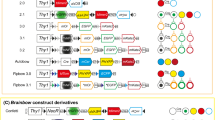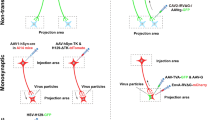Abstract
Lentiviral vectors are valuable tools to express genes of interest in living animals and stem cell cultures. The use of promoters in lentiviral constructs has been successfully used to drive gene expression in particular cell types including neurons and glia of the central nervous system in vivo. However, their suitability in cell culture is less well documented. In this paper, we describe lentiviral vectors containing neuronal promoters of the murine stem cell virus, of the synapsin 1 gene, the tubulin alpha 1 gene, and the calmodulin kinase II gene, and the glial promoter of the glial fibrillary acidic protein gene to drive reporter gene expression in primary dissociated cerebellar cell cultures and in slice cultures. While the glial promoter was highly specific for glia, the neuronal promoters were active in neurons and glia of dissociated cultures to a comparable extent. In slice cultures, neuronal and glial promoters demonstrated higher, but not absolute selectivity for particular cell types. In addition, the promoters allowed for an efficient and graded expression of genes in dissociated cultures. By using selected combinations of vectors, it was also possible to drive the expression of two genes in one cell type with high efficiency. A gene of interest in combination with a reporter gene can thus be expressed in a graded manner to reveal gene function in a rather short time and in a complex cellular environment.







Similar content being viewed by others
Abbreviations
- MBP:
-
Myelin basic protein
- GFAP:
-
Glial fibrillary acidic protein
- MSCV:
-
Murine stem cell virus
- CMV:
-
Cytomegalovirus
- Syn1:
-
Synapsin 1
- Ta1:
-
Tubulin alpha 1
- CaMKII:
-
Calmodulin kinase II
- CAG:
-
Chicken beta actin
- BSA:
-
Bovine serum albumin
- GFP/RFP:
-
Green/red fluorescent protein
- MAP:
-
Microtubule-associated protein
References
al Yacoub N, Romanowska M, Haritonova N, Foerster J (2007) Optimized production and concentration of lentiviral vectors containing large inserts. J Gene Med 9:579–584
Anliker B, Abel T, Kneissl S, Hlavaty J, Caputi A, Brynza J, Schneider IC, Munch RC, Petznek H, Kontermann RE, Koehl U, Johnston IC, Keinanen K, Muller UC, Hohenadl C, Monyer H, Cichutek K, Buchholz CJ (2010) Specific gene transfer to neurons, endothelial cells and hematopoietic progenitors with lentiviral vectors. Nat Methods 7:929–935
Baader SL, Bucher S, Schilling K (1997) The developmental expression of neuronal nitric oxide synthase in cerebellar granule cells is sensitive to GABA and neurotrophins. Dev Neurosci 19:283–290
Blow N (2009) Journeys across the membrane. Nature 458:239–242
Boukhtouche F, Janmaat S, Vodjdani G, Gautheron V, Mallet J, Dusart I, Mariani J (2006) Retinoid-related orphan receptor alpha controls the early steps of Purkinje cell dendritic differentiation. J Neurosci 26:1531–1538
Brenner M, Kisseberth WC, Su Y, Besnard F, Messing A (1994) GFAP promoter directs astrocyte-specific expression in transgenic mice. J Neurosci 14:1030–1037
Bulger M, Groudine M (2011) Functional and mechanistic diversity of distal transcription enhancers. Cell 144:327–339
Crespi B (2013) Diametric gene-dosage effects as windows into neurogenetic architecture. Curr Opin Neurobiol 23:143–151
de Backer MW, Garner KM, Luijendijk MC, Adan RA (2011) Recombinant adeno-associated viral vectors. Methods Mol Biol 789:357–376
Donnelly ML, Luke G, Mehrotra A, Li X, Hughes LE, Gani D, Ryan MD (2001) Analysis of the aphthovirus 2A/2B polyprotein ‘cleavage’ mechanism indicates not a proteolytic reaction, but a novel translational effect: a putative ribosomal ‘skip’. J Gen Virol 82:1013–1025
Dull T, Zufferey R, Kelly M, Mandel RJ, Nguyen M, Trono D, Naldini L (1998) A third-generation lentivirus vector with a conditional packaging system. J Virol 72:8463–8471
Follenzi A, Ailles LE, Bakovic S, Geuna M, Naldini L (2000) Gene transfer by lentiviral vectors is limited by nuclear translocation and rescued by HIV-1 pol sequences. Nat Genet 25:217–222
Frost J, Monk D, Moschidou D, Guillot PV, Stanier P, Minger SL, Fisk NM, Moore HD, Moore GE (2011) The effects of culture on genomic imprinting profiles in human embryonic and fetal mesenchymal stem cells. Epigenetics 6:52–62
Funke S, Maisner A, Muhlebach MD, Koehl U, Grez M, Cattaneo R, Cichutek K, Buchholz CJ (2008) Targeted cell entry of lentiviral vectors. Mol Ther 16:1427–1436
Fux C, Langer D, Kelm JM, Weber W, Fussenegger M (2004) New-generation multicistronic expression platform: pTRIDENT vectors containing size-optimized IRES elements enable homing endonuclease-based cistron swapping into lentiviral expression vectors. Biotechnol Bioeng 86:174–187
Goenawan H, Hirai H (2012) Modulation of lentiviral vector tropism in cerebellar Purkinje cells in vivo by a lysosomal cysteine protease cathepsin K. J Neurovirol 18:521–531
Goodrich JA, Tjian R (2010) Unexpected roles for core promoter recognition factors in cell-type-specific transcription and gene regulation. Nat Rev Genet 11:549–558
Hawley RG, Lieu FH, Fong AZ, Hawley TS (1994) Versatile retroviral vectors for potential use in gene therapy. Gene Ther 1:136–138
Hioki H, Kameda H, Nakamura H, Okunomiya T, Ohira K, Nakamura K, Kuroda M, Furuta T, Kaneko T (2007) Efficient gene transduction of neurons by lentivirus with enhanced neuron-specific promoters. Gene Ther 14:872–882
Hirai H (2008) Progress in transduction of cerebellar Purkinje cells in vivo using viral vectors. Cerebellum 7:273–278
Hoser M, Baader SL, Bosl MR, Ihmer A, Wegner M, Sock E (2007) Prolonged glial expression of Sox4 in the CNS leads to architectural cerebellar defects and ataxia. J Neurosci 27:5495–5505
Hu T, Fu Q, Chen P, Zhang K, Guo D (2009) Generation of a stable mammalian cell line for simultaneous expression of multiple genes by using 2A peptide-based lentiviral vector. Biotechnol Lett 31:353–359
Huang J, Gao J, Lv X, Li G, Hao D, Yao X, Zhou L, Liu D, Wang R (2010) Target gene therapy of glioma: overexpression of BAX gene under the control of both tissue-specific promoter and hypoxia-inducible element. Acta Biochim Biophys Sin (Shanghai) 42:274–280
Janas J, Skowronski J, Van Aelst L (2006) Lentiviral delivery of RNAi in hippocampal neurons. Methods Enzymol 406:593–605
Jankowski J, Holst MI, Liebig C, Oberdick J, Baader SL (2004) Engrailed-2 negatively regulates the onset of perinatal Purkinje cell differentiation. J Comp Neurol 472:87–99
Karra D, Dahm R (2010) Transfection techniques for neuronal cells. J Neurosci 30:6171–6177
Kim DG, Kang HM, Jang SK, Shin AS (1992) Construction of a bifunctional mRNA in the mouse by using the internal ribosomal entry site of the encephalomyocarditis virus. Mol Cell Biol 12:3636–3643
Kim JH, Lee SR, Li LH, Park HJ, Park JH, Lee KY, Kim MK, Shin BA, Choi SY (2011) High cleavage efficiency of a 2A peptide derived from porcine teschovirus-1 in human cell lines, zebrafish and mice. PLoS One 6:e18556
Kriegstein AR, Gotz M (2003) Radial glia diversity: a matter of cell fate. Glia 43:37–43
McIver SR, Lee CS, Lee JM, Green SH, Sands MS, Snider BJ, Goldberg MP (2005) Lentiviral transduction of murine oligodendrocytes in vivo. J Neurosci Res 82:397–403
Miyazaki J, Takaki S, Araki K, Tashiro F, Tominaga A, Takatsu K, Yamamura K (1989) Expression vector system based on the chicken beta-actin promoter directs efficient production of interleukin-5. Gene 79:269–277
Moldrich RX, Dauphinot L, Laffaire J, Rossier J, Potier MC (2007) Down syndrome gene dosage imbalance on cerebellum development. Prog Neurobiol 82:87–94
Naldini L, Blomer U, Gage FH, Trono D, Verma IM (1996a) Efficient transfer, integration, and sustained long-term expression of the transgene in adult rat brains injected with a lentiviral vector. Proc Natl Acad Sci USA 93:11382–11388
Naldini L, Blomer U, Gallay P, Ory D, Mulligan R, Gage FH, Verma IM, Trono D (1996b) In vivo gene delivery and stable transduction of nondividing cells by a lentiviral vector. Science 272:263–267
Oberdick J, Smeyne RJ, Mann JR, Zackson S, Morgan JI (1990) A promotor that drives transgene expression in cerebellar Purkinje and retinal bipolar neurons. Science 248:223–225
Osterfield M, Kirschner MW, Flanagan JG (2003) Graded positional information: interpretation for both fate and guidance. Cell 113:425–428
Pfeifer A, Hofmann A (2009) Lentiviral transgenesis. Methods Mol Biol 530:391–405
Pfeifer A, Verma IM (2001) Gene therapy: promises and problems. Annu Rev Genomics Hum Genet 2:177–211
Sawada Y, Kajiwara G, Iizuka A, Takayama K, Shuvaev AN, Koyama C, Hirai H (2010) High transgene expression by lentiviral vectors causes maldevelopment of Purkinje cells in vivo. Cerebellum 9:291–302
Sgado P, Alberi L, Gherbassi D, Galasso SL, Ramakers GM, Alavian KN, Smidt MP, Dyck RH, Simon HH (2006) Slow progressive degeneration of nigral dopaminergic neurons in postnatal Engrailed mutant mice. Proc Natl Acad Sci USA 103:15242–15247
Smith AD, Sumazin P, Zhang MQ (2007) Tissue-specific regulatory elements in mammalian promoters. Mol Syst Biol 3:1–8
Suzuki K, Kelleher AD (2009) Transcriptional regulation by promoter targeted RNAs. Curr Top Med Chem 9:1079–1087
Tabata T, Sawada S, Araki K, Bono Y, Furuya S, Kano M (2000) A reliable method for culture of dissociated mouse cerebellar cells enriched for Purkinje neurons. J Neurosci Methods 104:45–53
Takayama K, Torashima T, Horiuchi H, Hirai H (2008) Purkinje-cell-preferential transduction by lentiviral vectors with the murine stem cell virus promoter. Neurosci Lett 443:7–11
Uetsuki T, Naito A, Nagata S, Kaziro Y (1989) Isolation and characterization of the human chromosomal gene for polypeptide chain elongation factor-1 alpha. J Biol Chem 264:5791–5798
Vu TH, Hoffman AR (1994) Promoter-specific imprinting of the human insulin-like growth factor-II gene. Nature 371:714–717
Wagner W, McCroskery S, Hammer JA III (2011) An efficient method for the long-term and specific expression of exogenous cDNAs in cultured Purkinje neurons. J Neurosci Methods 200:95–105
Wrabetz L, Shumas S, Grinspan J, Feltri ML, Bozyczko D, McMorris FA, Pleasure D, Kamholz J (1993) Analysis of the human MBP promoter in primary cultures of oligodendrocytes: positive and negative cis-acting elements in the proximal MBP promoter mediate oligodendrocyte-specific expression of MBP. J Neurosci Res 36:455–471
Wrabetz L, Taveggia C, Feltri ML, Quattrini A, Awatramani R, Scherer SS, Messing A, Kamholz J (1998) A minimal human MBP promoter-lacZ transgene is appropriately regulated in developing brain and after optic enucleation, but not in shiverer mutant mice. J Neurobiol 34:10–26
Zufferey R, Nagy D, Mandel RJ, Naldini L, Trono D (1997) Multiply attenuated lentiviral vector achieves efficient gene delivery in vivo. Nat Biotechnol 15:871–875
Acknowledgments
All authors gave their informed consent prior to their inclusion in the study. We very much appreciate the excellent technical help of Stefanie Ramrath and Helma Langmann. We also are grateful to the help of Daniela Krauss and Franz Neuhalfen for providing timed pregnant mice. The MSCV promoter was kindly provided by Dr. Neumann (Institute of Reconstructive Neurobiology, University of Bonn) and the GFAP promoter by Dr. Sock (Institute of Biochemistry, University of Erlangen).
Author information
Authors and Affiliations
Corresponding author
Rights and permissions
About this article
Cite this article
Kumar, S., Zimmermann, K., Hioki, H. et al. Efficient and graded gene expression in glia and neurons of primary cerebellar cultures transduced by lentiviral vectors. Histochem Cell Biol 143, 109–121 (2015). https://doi.org/10.1007/s00418-014-1260-8
Accepted:
Published:
Issue Date:
DOI: https://doi.org/10.1007/s00418-014-1260-8




